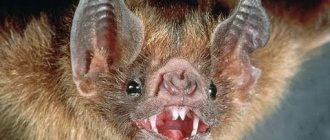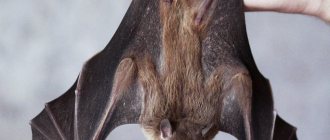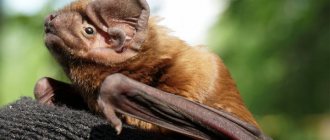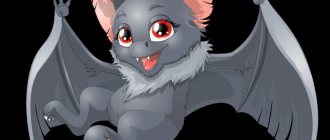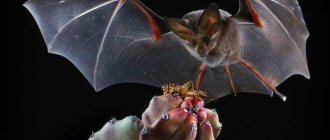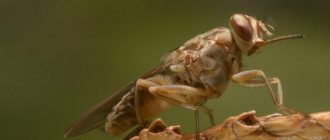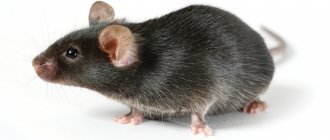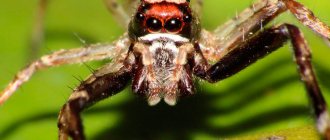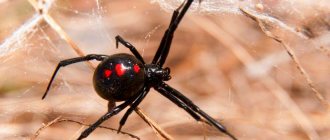What does a brown long-eared bat look like: photo and description
The body length of the animal ranges from 44 mm to 52 mm, the length of the tail is slightly shorter than the length of the body. The brown long-eared bat weighs 6-12 grams.
In appearance, it is in many ways similar to its close relative - the rather large gray long-eared bat (Plecotus austriacus), and only a specialist can often distinguish between these two species.
The length of the animal's ears significantly exceeds two-thirds of the body length. When the long eared eardrum is at rest, this feature may not be noticed, since at this time the ears are folded and covered by the flying membrane, but the tragus remain straightened. The animal hides its ears, apparently in order to protect them from damage or attack, for example, by blood-sucking insects, and also to prevent moisture loss through a large surface of the skin. The anterior edges of the bases of the ears above the forehead are connected by a small (about 2 mm in height) fold of skin.
In the photo, the brown (common) long-eared bat has curled up ears.
The fur covering the body of the animal is fluffy and silky, on the underside of the body it is very light, almost whitish, on top it is darker - light gray, with a brown tint.
The bases of the hair on both the lower and upper sides of the body are dark brown. The ends of the hair on the ventral side are almost white, on the dorsal side they are two-colored, the lower part is light, and the end part is grayish-brown. Those. the hair on the lower surface of the body is two-colored, and on the upper surface it is tricolored. Juveniles are slightly darker than adults.
The wings of the brown long-eared bat are wide and have rounded outlines. The flying membrane is dark brown. The space between the tip of the nose and the eyes is covered with hair. The nostrils open on the upper surface of the nose.
The tail membrane covers the hind leg to the base of the outer toe and leaves the last caudal vertebra free.
Who are the Ushans?
Long-eared bats belong to the large family of smooth-nosed bats. They have nothing in common with real mice and other rodents, except that they are also mammals. They most likely received this name due to their squeaky voice and small size.
Long-eared bats represent a separate genus, which includes about 19 species. Outwardly, they are not much different from each other. All have thick fur, well-developed auricles (tragus) and a smooth muzzle, devoid of special growths of osteochondral tissue.
The species Plecotus sardus, or Sardinian long-eared bat, is endemic to the Italian island of the same name. It is found in forested lower reaches or near the coast. The gray long-eared bat is similar to it, but slightly smaller in size. It lives in North Africa, Central and Eastern Europe, flying in forests, over parks and gardens. It is considered a twin of the common long-eared bat (brown), since they have similarities in lifestyle, color and structure. Due to their strong similarity, they were not distinguished until the 1960s, being considered subspecies of the same species.
Hunting and echolocation
The brown long-eared bat is a mammal that hunts small animals. Its diet consists mainly of insects and other invertebrates, such as chafers, butterflies, moths, caterpillars, etc. Unlike giant noctules or pseudo-vampires, they cannot handle larger prey.
A characteristic feature of all long-eared cats is their large ears, which help them better pick up echolocation signals. Their size is almost equal to the length of the mouse’s body and is 3-4 centimeters. Brown long-eared monkeys emit low-frequency waves, invisible to humans and many animals, in the range of 25-85 kHz with an amplitude of 50 kHz. Reflecting from various objects, they give mice information about how the objects around them are located.
Echolocation is primarily used for orientation in space, as well as for communication between relatives. Like birds, when talking they sing songs consisting of a dozen syllables in different sequences. The only difference is that their trills are not audible to all creatures.
Echolocation also helps bats locate food. True, some insects have learned to block their signals or use their own to deceive predators. During the hunt, long-eared animals may not use “superpowers” at all, relying on their eyesight and excellent hearing. The sensitivity of their ears allows them to recognize the flapping of a moth's wings at a distance of several meters.
Support the site
Taxonomic affiliation:
Class - Mammals (Mammalia), series - Chiroptera (Chiroptera), family - Smooth-nosed bats (Vespertilionidae). One of 8 species of the genus, one of 2 species of the genus of fauna in Ukraine.
Conservation status of the species:
Vulnerable.
Range of the species and its distribution in Ukraine:
Distributed throughout most of Eurasia, the Caucasus, and in the village. Africa. In Ukraine, it is distributed throughout the entire territory, except for the steppe regions, isolated in the Crimean Mountains. The most continuous habitat is in Polesie.
Number and reasons for its change
Low, about 100-200 finds are known in Ukraine, both summer and winter, which account for up to 4% of the volume of bat collections, the same proportion of the species in winter concentrations of bats. The total population size is several tens of thousands of individuals.
Reasons for the change in numbers:
destruction of hollow trees. In underground storage facilities, anxiety is an unfavorable factor.
Features of biology and scientific significance:
The typical habitat is mixed and coniferous forests, as well as floodplain and ravine forests and forest parks. It settles in tree hollows, and in severe winters it is found in dungeons (often in adjacent halls). Does not form large accumulations. Leads a predominantly solitary lifestyle, forming maternal colonies of 15-30 individuals in summer and autumn. Sedentary, carries out only local seasonal migrations. In autumn, they are often observed in artificial nesting sites. The flight is maneuverable; hunts small nocturnal insects in clearings, forest edges and gardens, often collecting food from the substrate (trunks and branches of trees). It reaches sexual maturity at 2 years of age and produces one baby once a year. A natural regulator of insect numbers and an indicator of slightly disturbed forest faunal groups.
Morphological characteristics:
General characteristics are typical for the genus: large ears (more than 30 mm), enlarged at the base, light brown fur on the back. Species characteristics: there are large (larger than the eyes) warts above the eyes; the end of the muzzle behind the nostrils is swollen; the free wing finger is long (6.2-7.2 mm); the apices of the tragus are light; belly with a yellow tint, penis narrow; forearms - 36 -41 mm.
Population conservation regime and protection measures:
According to the latest information, the IUCN category is LC, EUROBATS, Berne Convention - Appendix II. It is protected in reserves of all natural areas. Effective protection can be achieved by creating large protected areas in the mixed forest zone and protecting natural repositories.
Reproduction and breeding in specially created conditions:
In general, the species is easy to keep in captivity, but breeding experience is unknown.
Economic and commercial significance:
Doesn't have.
General information about bats
The animal belongs to the bats. This is an order of mammals in which the wings and forelimbs form a single unit. Mice have very long fingers, which serve as the frame for their membranous wings. This feature distinguishes them from birds. While birds can soar without moving their outstretched wings, bats are forced to constantly flap them. The average speed of movement is about 15 km/h, and during hunting it is 60 km/h.
The landing style of mice is also completely different from that of birds. In a short time they slow down and immediately take a vertical position, clinging to the surface with their tenacious paws, upside down.
Bats do not build nests; they feed mainly in flight. It will take a mouse no more than an hour to catch a couple of hundred mosquitoes.
Vampires - bats
This type of mouse belongs to the category of parasites and poses a threat to humans and their pets. Deadly infectious agents are transmitted through the bites of vampire animals.
They feed on fresh blood of livestock and birds. Extreme hunger can force a person to attack. Echolocation is poorly developed, but there are excellent receptors with infrared radiation (helps to determine the most defenseless area on the skin) and a hearing aid. They inhabit the territories of South and Central America.
Lifestyle
Long-eared bats live in different types of landscapes. They can live in forests, mountains and woodlands. They are often found in city parks, gardens and along roads. They live alone or in small groups. When raising offspring, they can unite into groups consisting of mothers and cubs.
These are sedentary animals. For the winter they do not fly away anywhere, but hibernate in a secluded place. For them, this is a hollow in a tree, a cave, a dark attic and a basement. Eared ears sleep there even in the summer, waiting out the day. When it gets completely dark, they go out, hunting until dawn.
The flight of long-eared bats resembles the fluttering of butterflies: fast and intermittent flapping of wings, circling around trees and frequent changes of trajectory. From time to time they may hover in the air, fluttering their wings, to collect a caterpillar or spider directly from a leaf or bark.
Interesting facts about this animal
Brown Capuchin
Brown long-eared bat is not a vampire. Unlike the common stereotype, this representative of bats is not a vampire at all. Yes, some bats do suck the blood of livestock, people, and sometimes babies, but in this case, the diet is spider bugs. This animal will not attack a person unnecessarily.
Sex upside down. This is true. This simple process in this species occurs in a “suspended” form; moreover, the mating dance must also be performed “in a suspended state.”
Placental animals. This means that long-eared cats have a placenta. Which, in turn, means that they are viviparous. The process is difficult to imagine, it’s easier to watch on YouTube, but yes, they can do this upside down too. In addition, it is the presence of the placenta as an organ during pregnancy that determines the predominant number of offspring, and in these mice there are only 1-2 chiropteran mice at a time.
The name of the species was given by the ears. And this is not surprising: brown long-eared monkeys have perhaps the largest ears, if you compare their length relative to the body. It happens that they turn out to be even larger than the body!
Excellent orientation in space. As you know, bats move in space using echolocation: they send a signal and catch a response with their ears. Being the most “eared”, these bats will give odds to all other bats when competing for orientation in space.
Ubiquitous residents. Attics, caves, abandoned houses and rooms, trees - this species can live anywhere. But, given that it is relatively safe (in fact, almost completely), you should not drive them out with a broom: they are quite gentle creatures that do not harm anyone, and even destroy pests.
They do not tolerate rabies. Unlike some “ordinary vampires”. These bats do not have the habit of sucking blood, they feed differently, and therefore cannot carry diseases such as rabies. However, they can bite in self-defense, and you shouldn’t forget about that.
It makes up a significant part of the diet of poor Chinese. A bat is a tasty, nutritious, but cheap delicacy, which is why in China and India this animal is quite readily included in soup. Considering that they are caught from the wild, they are most often teeming with parasites and diseases, so it’s not worth the risk, even if you really want to.
Fast growing animals. Due to their size, these animals grow quickly: for example, a newborn long-eared bat, which appears at the beginning of summer, is attached to the abdomen of its mother for a month, who carries it with her everywhere until it learns to fly (the father is usually far, far away at this time). But after about a month (30 days) he becomes the size of his mother. She looks after him a little more, teaches him and, in the end, leaves him alone.
Bites can be dangerous. But only because this animal is a predator, and accordingly, on its teeth it carries a lot of infection that develops on the remains of cadaveric tissue
Most often, earflaps are harmless, so you need to carefully take them outside and not attack them with a broom, and if a bite does occur, consult a doctor, not forgetting to treat the wound with brilliant green or iodine.
Singles. This type of bat is distinguished by its loneliness: they do not live in colonies, but more often alone, meeting with relatives only during breeding
During this same period, females sometimes gather in small groups (10-20 individuals), give birth together and help each other feed their young. After they grow up, their mothers leave them and their friends to go about their own business.
One of the longest-living species of bats. If, of course, we talk about bats. Thus, in 1990, a female was recaptured in Germany, which, judging by banding data, had already been encountered by local biologists 30 years ago. It is worth considering that most, for example, house bats live 1-3 years.
